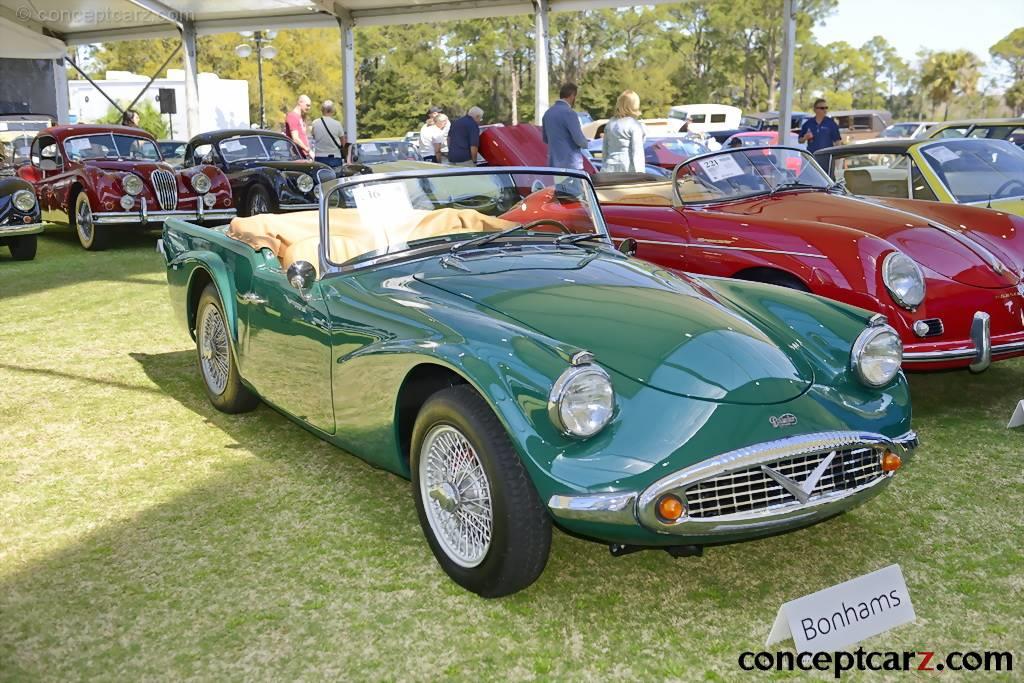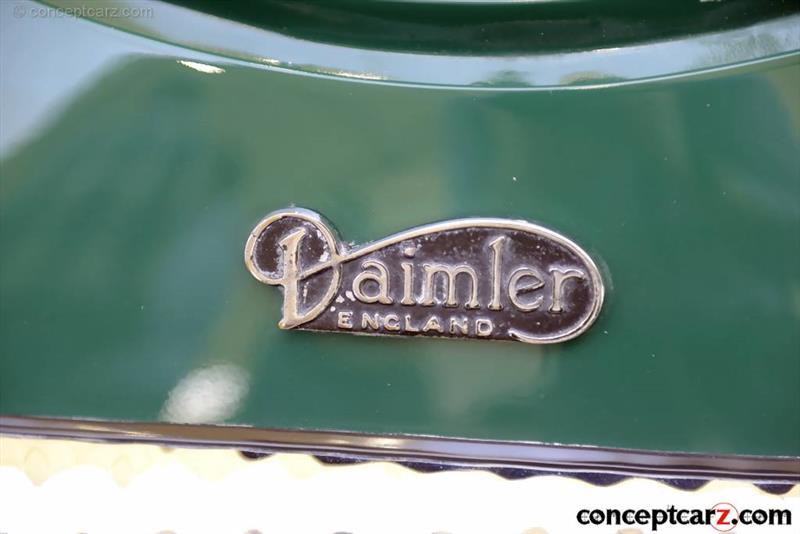H. J. Lawson founded The Daimler Motor Company Limited in 1896, becoming The Daimler Company Limited after 1910, the year it was acquired by Birmingham Small Arms Company (BSA). When BSA acquired the Lanchester Motor Company in 1933, it was made a subsidiary of the Daimler Company. Between 1902 and the 1950s, Daimler had a Royal Warrant to provide cars to the British monarch. Many of the vehicles produced by Daimler were elegant and stately limousines, yet just before its acquisition by Jaguar, the company introduced a drastic departure from the 'norm' with the SP250 sports car. It was given a separate ladder-type chassis on which sat controversially styled fiber-glass coachwork manufactured by Daimler themselves. Beneath the bonnet was a 2.5-liter V8 engine that was kept in check via the four-wheel disc brakes. This engine was the smaller of Daimler's two Edward Turner-designed V8s and delivered 140 horsepower, enough to propel the SP250 to a top speed of 125 mph. Aimed at the North American market and launched in 1959, the SP250 was offered with an optional automatic transmission. The Daimler SP250 survived Jaguar's 1960 take-over, benefiting from its new owner's attention that resulted in the much-improved 'B' version introduced in April of 1961. It gained a stiffer chassis and thicker fiberglass coachwork. The 'C' version arrived in April of 1963 and differed only in detail. Production ceased in 1964. Edward Turner was appointed Managing Director of BSA's Automotive Division in 1956 and by March 1958, had finalized the drawings for the V8 engine. The saloon prototype, project number DN250, was not available at the time to be considered for feasibility. Instead, the SP250 sports car project was analyzed and determined that a profit could be made if sufficient numbers were produced, with most of the sales expected to come from the United States. Both steel and fiberglass bodies were considered, with the fiberglass material being selected due to its affordability, shorter production time, and lower cost to modify the styling. Specification
The Turner-designed engine displaced 2,547cc (2.5-liters) and had a bore of 75 mm and stroke of 70mm. It was a water-cooled unit with an iron block, aluminum alloy hemispherical cylinder heads, five-bearing crankshaft, and an 8.2:1 compression ratio. It used an SU electric fuel pump, twin SU carburetors, and a single central camshaft to operate valves through short pushrods. Horsepower was rated at 140 bhp at 5,800 RPM and torque at 155 lb-ft at 3,600 RPM. The engine was backed by a four-speed transmission with synchromesh on the top three ratios. This gearbox was reverse-engineered from the Standard gearbox used in the Triumph TR3A and was the first of this type used by Daimler. Prior to this, the company had primarily used pre-selector-type gearboxes for their vehicles dating back to the 1930s. The Hypoid bevel rear axle had a 3.58:1 ratio, and the steering was by Cam & follower. The front suspension was comprised of coil springs while the rear used a live axle with half-elliptic leaf springs. The wheelbase measured 92 inches and the length of 165 inches. Introduction
Daimler introduced its new sports car in 1959 at the New York Motor Show where it was unofficially voted as the ugliest car at the show. If this wasn't bad enough, Daimler had introduced the vehicle as the Daimler Dart, which prompted Chrysler, whose Dodge division owned the trademark for the 'Dart' model name, to threaten legal action if the name was not changed. So Daimler quickly renamed it to the project number, SP250. A-Spec
The first iteration of the SP250, later dubbed the A-spec, had a 14-gauge ladder frame reinforced with cruciform bracing. These proved inadequate as the frame tended to flex, and occasionally the doors would come open. The B-Spec version remedied this issue with the addition of outriggers on the chassis and a strengthening hoop between the A-posts.Additional unique features of the early A-Spec cars included recessed behind-the-door handles and chromium-plated 'whiskers' on the body flanking the front grille, joined by two short, vertical bumpers (overriders) at the rear. If the rear optional bumper was added, the overriders were removed. B-Spec
Along with chassis improvements and thicker fiberglass, the SP250 received an adjustable steering column and was devoid of the 'whiskers.'
Roadster
Chassis #: 104198
Engine #: 97411
View info and history
Auction entries : 3C-Spec
Daimler introduced the C-Spec version in April of 1963 with standard equipment that included a cigarette lighter, a trickle charger socks, and a heater/demister unit. Like the B-Spec, it, too, did not have the 'whiskers.' Production
The Daimler SP250 was produced from 1959 through 1964, with a total of 2,654 examples built during that time. The feasibility study predicted that 1,500 examples would be sold in the first year of production and 3,000 examples per year for the second and third years of production. Thus, the SP250 did not achieve profitability for the company.A replacement for the SP250 was considered but scrapped due to the poor sales of the SP250 and the competition it would add to Jaguar's more expensive sports car, the E-Type.
by Daniel Vaughan | Apr 2022
The Turner-designed engine displaced 2,547cc (2.5-liters) and had a bore of 75 mm and stroke of 70mm. It was a water-cooled unit with an iron block, aluminum alloy hemispherical cylinder heads, five-bearing crankshaft, and an 8.2:1 compression ratio. It used an SU electric fuel pump, twin SU carburetors, and a single central camshaft to operate valves through short pushrods. Horsepower was rated at 140 bhp at 5,800 RPM and torque at 155 lb-ft at 3,600 RPM. The engine was backed by a four-speed transmission with synchromesh on the top three ratios. This gearbox was reverse-engineered from the Standard gearbox used in the Triumph TR3A and was the first of this type used by Daimler. Prior to this, the company had primarily used pre-selector-type gearboxes for their vehicles dating back to the 1930s. The Hypoid bevel rear axle had a 3.58:1 ratio, and the steering was by Cam & follower. The front suspension was comprised of coil springs while the rear used a live axle with half-elliptic leaf springs. The wheelbase measured 92 inches and the length of 165 inches. Introduction
Daimler introduced its new sports car in 1959 at the New York Motor Show where it was unofficially voted as the ugliest car at the show. If this wasn't bad enough, Daimler had introduced the vehicle as the Daimler Dart, which prompted Chrysler, whose Dodge division owned the trademark for the 'Dart' model name, to threaten legal action if the name was not changed. So Daimler quickly renamed it to the project number, SP250. A-Spec
The first iteration of the SP250, later dubbed the A-spec, had a 14-gauge ladder frame reinforced with cruciform bracing. These proved inadequate as the frame tended to flex, and occasionally the doors would come open. The B-Spec version remedied this issue with the addition of outriggers on the chassis and a strengthening hoop between the A-posts.Additional unique features of the early A-Spec cars included recessed behind-the-door handles and chromium-plated 'whiskers' on the body flanking the front grille, joined by two short, vertical bumpers (overriders) at the rear. If the rear optional bumper was added, the overriders were removed. B-Spec
Along with chassis improvements and thicker fiberglass, the SP250 received an adjustable steering column and was devoid of the 'whiskers.'

Roadster
Chassis #: 104198
Engine #: 97411
View info and history
Auction entries : 3
Daimler introduced the C-Spec version in April of 1963 with standard equipment that included a cigarette lighter, a trickle charger socks, and a heater/demister unit. Like the B-Spec, it, too, did not have the 'whiskers.' Production
The Daimler SP250 was produced from 1959 through 1964, with a total of 2,654 examples built during that time. The feasibility study predicted that 1,500 examples would be sold in the first year of production and 3,000 examples per year for the second and third years of production. Thus, the SP250 did not achieve profitability for the company.A replacement for the SP250 was considered but scrapped due to the poor sales of the SP250 and the competition it would add to Jaguar's more expensive sports car, the E-Type.
by Daniel Vaughan | Apr 2022
Related Reading : Daimler 250 History
The last Daimler car to feature a Daimler engine, the Daimler 250 was produced in Coventry, England in 1963. The original Dart was introduced in 1959 at the New York Motor show. At first, it was remarkably popular with a fiberglass body, 2.5-liter Hemi-head V8 and four-wheel Girling disc brakes. After being threatened with legal repercussions by Chryslers Dodge division, the Dart name was dropped....
Continue Reading >>
Continue Reading >>
Similar Automakers
Similarly Sized Vehicles
from 1963
Similarly Priced Vehicles
1963 Daimler SP 250 Vehicle Profiles
Recent Vehicle Additions
Performance and Specification Comparison
Price Comparison
250 Specification Comparison by Year
Year
Production
Wheelbase
Engine
Prices
Related Automotive News

Callaway Twin Turbo Corvette & Panoz 10th Anniversary Roadster Hit Collecting Cars Auction
1988 Chevrolet Corvette Callaway Twin Turbo Aerobody and 1999 Panoz AIV Roadster 10Th Anniversary Edition Debut On Collecting Cars U.S. Auction Platform
A 1988 Chevrolet...

The Ultimate Beach Cruiser: The 1974 Volkswagen Acapulco Thing
The Volkswagen Type 181 – commonly referred to as The Thing – has always been a fun summer classic for drivers who enjoy a cool and wildly original type of ride. The removable doors, retractable soft top and folding windshield provided a driving experience...

London Concours 2020 To Celebrate 'Lost Marques'
The London Concours has announced the Lost Marques display – an homage to those marques we have loved and lost
Models from the likes of Facel Vega, Bizzarrini, Austin Healey, Alvis, Jensen and many more will grace the lawn as part of the display...

Extremely Original 'Holy Grail' 1970 Oldsmobile 442 W-30 Convertible at Russo and Steele's 2016 Arizona Auction Event
Scottsdale, Arizona (November 24, 2015) – While Oldsmobile is believed to have created the first true American muscle car with the release of its 303 V-8 Rocket 88 in 1949, it was not until 1964 that it returned to the concept with the 442 option,...

Carroll Shelby, Ford Family for More Than Half a Century
Carroll Shelby was a member of the Ford family for the better part of 60 years, producing stunning performance vehicles from concepts to production models.
He once said his energy and passion for performance products were always strongest when he was...


























